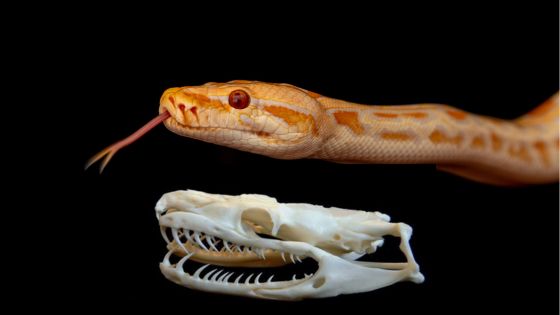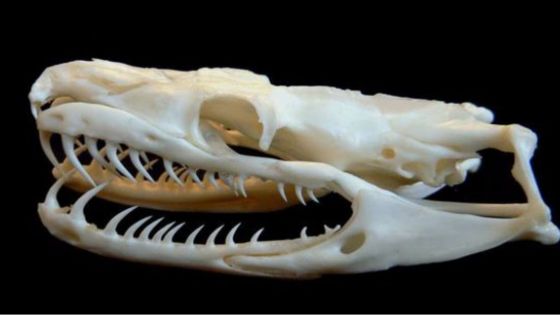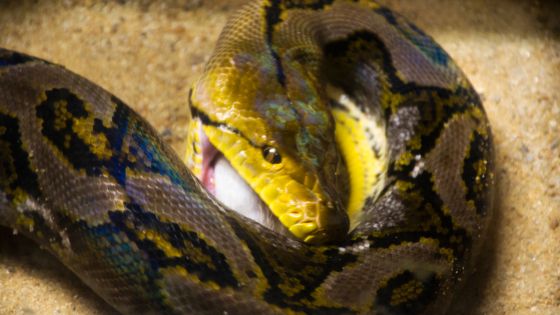Reticulated Python Teeth: A Comprehensive Exploration of Dental Anatomy and Function

Reticulated Python Teeth? Welcome to an exciting journey into the world of the reticulated python, one of the longest snakes on the planet.
This comprehensive guide delves into a specific aspect of these fascinating creatures: their teeth. We'll explore everything you need about the reticulated Python teeth, from their unique structure to various functions.
So, if you've ever wondered about the dental anatomy of the largest snake in the world, you're in the right place. Let's dive in!
What makes the reticulated python's teeth so intriguing? Is it their size, shape, or function? Or is it the way they are used in the wild?
In this article, we'll explore all these aspects and more. Whether you're a herpetologist, a snake enthusiast, or just curious about the natural world, this guide will provide insights and information you may not have known.
We'll cover everything from understanding the basic anatomy to exploring how these snakes use their teeth to catch their prey.
And don't worry, we've included some background color to the story, so it's not just a dry scientific text. So grab a seat, and let's explore the fascinating world of the reticulated python!
- Reticulated Python Teeth Overview
- Anatomy of Reticulated Python Teeth
- The function of Reticulated Python Teeth
- Study and Research on Reticiculated Python Teeth
- Management and Utilization of Reticulated Python Teeth
- Exploration and Journey of Reticulated Python Teeth
- Takeaway
- Frequently Asked Questions
Reticulated Python Teeth Overview
The reticulated python, known scientifically as Python reticulatus, is famous for its intricate pattern and impressive length.
But what about the teeth? The teeth of the reticulated python are a marvel in themselves. They are designed to grip and hold their prey, allowing the snake to constrict and consume it.
When talking about the size and shape of reticulated python teeth, you'll find that they are long, sharp, and curved backward.
This design ensures that it's nearly impossible to escape once the prey is caught. The teeth's composition and structure are equally fascinating, made of dentin and covered in enamel, much like human teeth.
But it's not just about the teeth; the reticulated python's entire mouth structure is a marvel of nature.
From the jaw's flexibility to the teeth's arrangement, everything works harmoniously to make the reticulated python one of the most efficient predators in the wild.
Curious about the world's longest snake? Read on to uncover essential facts about the reticulated python, including their biology, behavior, captive care requirements, and conservation. As apex predators, these snakes play vital ecological roles and face threats.
Learn how you can help support reticulated python conservation efforts and responsible stewardship. Expand your knowledge of these magnificent giant snakes in this informative article - click now!
Anatomy of Reticulated Python Teeth

Understanding the anatomy of reticulated python teeth requires a deep dive into their morphology and arrangement.
These snakes have numerous teeth, all aligned to ensure a firm grip on their prey. The teeth are not only in the upper and lower jaws but also in the roof of the mouth, providing multiple contact points.
The development and growth of the teeth are also intriguing. Reticulated pythons continuously replace their teeth throughout their lives. If a tooth is lost or broken, a new one grows.
This ensures they have a full set of functional teeth ready for the next meal.
When caring for and maintaining reticulated python teeth, nature has it all figured out. The snake's saliva contains enzymes that help clean the teeth, and their raw meat diet ensures no deposits are left behind. It's a self-sustaining system that works flawlessly in the wild.
Bitten by a retic? Learn to treat symptoms rapidly, seek medical care, and prevent future strikes—critical knowledge for safe handling. Click now!
The function of Reticulated Python Teeth
The primary function of reticulated python teeth is to catch and hold their prey. The backward-curving design ensures that once the prey is caught, it cannot escape.
This is essential for the snake, as it allows it to constrict its prey without the risk of it slipping away.
But it's not just about catching food. The teeth also play a role in the snake's defensive mechanisms. If threatened, the reticulated python can deliver a painful bite, using its teeth to warn potential predators.
This dual function of feeding and defense showcases the teeth's importance in the snake's daily life.
Interestingly, the teeth also play a role in the snake's feeding process after catching the prey. They help maneuver the prey into the correct position for swallowing, showcasing yet another aspect of their multifunctional design.
Study and Research on Reticiculated Python Teeth
Studying reticulated python teeth has provided valuable insights into the snake's biology, behavior, and ecology.
Through observation and examination, scientists have understood how the teeth function and their role in the snake's life.
Analysis and evaluation of the teeth have also led to discoveries about the snake's diet and hunting strategies.
By understanding how the teeth are used, researchers can infer what prey the snake prefers and how it catches it.
Furthermore, the study of reticulated python teeth has broader implications for understanding reptilian dental anatomy.
It offers a window into the evolutionary processes that have shaped these incredible creatures and their environmental adaptations.
Management and Utilization of Reticulated Python Teeth

While the primary focus of this article is on the reticulated python in the wild, it's worth noting how these snakes and their teeth are managed and utilized by humans.
Reticulated pythons are kept as exotic pets in some parts of the world, including the United States.
Managing these snakes requires understanding their dental needs and ensuring they are met. This includes providing appropriate food and monitoring the teeth for any signs of damage or disease.
Additionally, the teeth of reticulated pythons have been studied for their potential applications in various fields.
From medical research to the design of new materials, the unique properties of these teeth offer exciting possibilities for innovation and discovery.
Exploration and Journey of Reticulated Python Teeth
Exploring reticulated python teeth is a journey that takes us into the heart of one of nature's most remarkable creatures.
From understanding their unique design to appreciating their multifunctional role, there's much to discover and learn.
The journey also takes us beyond the snake into the broader world of reptilian biology and evolution.
By studying the teeth of the reticulated python, we gain insights into how nature designs and builds such complex and efficient systems.
Whether you're a professional herpetologist or just curious about the natural world, exploring reticulated python teeth offers a fascinating and rewarding adventure. It's a journey that reveals the beauty and complexity of life on our planet.
Takeaway
We've come to the end of exploring reticulated python teeth, and what a journey it's been! We've covered everything from understanding the basic anatomy to delving into their various functions and applications.
The reticulated python is indeed a marvel of nature, and its teeth are a testament to the intricate design and efficiency that nature can achieve.
If you've enjoyed this journey and want to learn more about the reticulated python or other fascinating creatures, don't hesitate to explore further.
The world of herpetology is vast and full of wonders waiting to be discovered. So why not take the plunge and dive into the wild world of snakes and reptiles? You may not regret it!
Frequently Asked Questions
What are the main functions of reticulated python teeth?
The main functions of reticulated python teeth are to catch and hold their prey, assist in swallowing, and serve as a defensive mechanism.
How do reticulated python teeth develop and grow?
Reticulated python teeth develop and grow continuously throughout the snake's life, replacing lost or broken teeth as needed.
What are the common methods used to study reticulated python teeth?
Common methods used to study reticulated python teeth include observation, examination, analysis, and evaluation.
How are reticulated Python teeth utilized in various applications?
Reticulated python teeth are utilized in various applications, including pet care, medical research, and material design.
Alejandro Morales, Herpetologist, and Wildlife Biologist reviewed and approved this article.
Note: This article is intended for informational purposes only and should not be considered professional advice. Always consult a qualified herpetologist or veterinarian for personalized guidance on caring for Burmese pythons and other reptiles.

